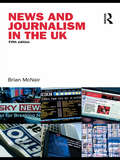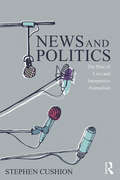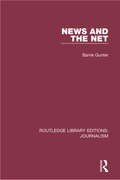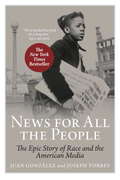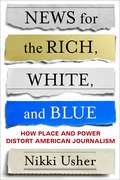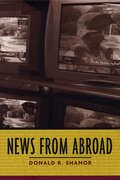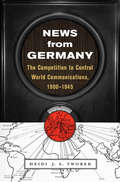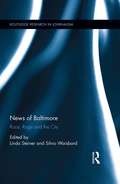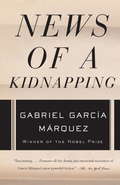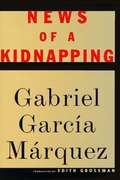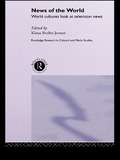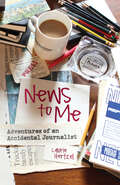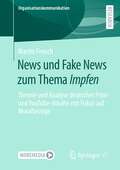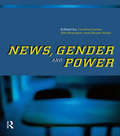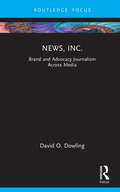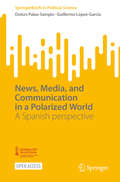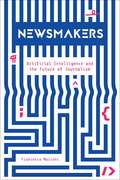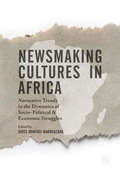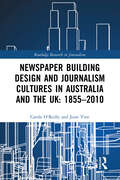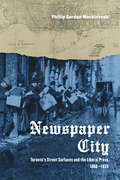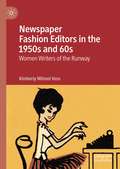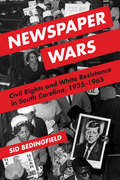- Table View
- List View
News and Journalism in the UK
by Brian McNairNews and Journalism in the UK is an accessible and comprehensive introduction to the political, economic and regulatory environments of press and broadcast journalism in Britain and Northern Ireland. Surveying the industry in a period of radical economic and technological change, Brian McNair examines the main trends in journalistic media in the last two decades and assesses the challenges and future of the industry in the new millennium. Integrating both academic and journalistic perspectives on journalism, topics addressed in this revised and updated edition include: the rise of online journalism and the impact of blogging on mainstream journalism the emergence of 24 hour news channels in the UK the role and impact of journalism, with reference to issues such as democracy, health scares and the war on terror trends in media ownership and editorial allegiances 'Tabloidisation', Americanisation and the supposed 'dumbing down' of journalistic standards the implications of devolution for regional journalists.
News and News Sources: A Critical Introduction (Mass Ser.)
by Paul ManningNews and News Sources offers a fresh introduction to the sociology of news. It is often suggested that the powerful dominate news agendas. Increasingly however, less powerful groups are employing sophisticated media strategies and new communication technologies to get their message across. The implications of this development are unclear. Do these developments herald a `democratisation' of news arenas, or will they enable the powerful further strengthen their control over the flow of information to the public domain? News and News Sources: reviews new research in the rapidly expanding field of political communication, drawing upon material from Britain, Europe and the USA; provides a clear introduction to the processes of news production and the implications of the rise in global electronic news communication; and assesses the various theoretical frameworks available for analysing these developments including fuctionalism, pluralism, Marxism, political economy, hegemony theory, discourse theory and postmodernism.
News and Politics: The Rise of Live and Interpretive Journalism (Communication and Society)
by Stephen CushionNews and Politics critically examines television news bulletins – still the primary source of information for most people – and asks whether the wider pace and immediacy of 24-hour news culture has influenced their format and style over time. Drawing on the concepts of mediatization and journalistic interventionism, Stephen Cushion empirically traces the shift from edited to live reporting from a cross-national perspective, focussing on the two-way convention in political coverage and the more interpretive approach to journalism it promotes. Challenging prevailing academic wisdom, Cushion argues that the mediatization of news does not necessarily reflect a commercial logic or a lowering of journalism standards. In particular, the rise of live two-ways can potentially enhance viewers’ understanding of public affairs – moving reporters beyond their visual backdrops and reliance on political soundbites – by asking journalists to scrutinize the actions of political elites, interpret competing source claims and to explain the broader context to everyday stories. Considering the future of 24-hour news, a final discussion asks whether new content and social media platforms – including Twitter and Buzzfeed – enhance or weaken democratic culture. This timely analysis of News and Politics is ideal for students of political communication and journalism studies, as well as communication studies, media studies, and political science.
News and the Net (Routledge Library Editions: Journalism #9)
by Barrie GunterOriginally published in 2003. This book examines the growth of news provision on the internet and its implications for news presentation, journalism practice, news consumers, and the business of running news organizations. Much of the focus is placed on the migration of newspapers onto the internet, but references are also made to the establishment of news websites by other organizations. The book examines the growth of online technology as a source of information and entertainment and considers how this development can be framed within models of communication and comments, on the apparent shortage of new models to explain the use, role, effectiveness, and impact of online communications.
News for All the People
by Juan Gonzalez Joseph TorresHere is a new, sweeping narrative history of American news media that puts race at the center of the story. From the earliest colonial newspapers to the Internet age, America's racial divisions have played a central role in the creation of the country's media system, just as the media has contributed to--and every so often, combated--racial oppression. News for All the People reveals how racial segregation distorted the information Americans received from the mainstream media. It unearths numerous examples of how publishers and broadcasters actually fomented racial violence and discrimination through their coverage. And it chronicles the influence federal media policies exerted in such conflicts. It depicts the struggle of Black, Latino, Asian, and Native American journalists who fought to create a vibrant yet little-known alternative, democratic press, and then, beginning in the 1970s, forced open the doors of the major media companies.The writing is fast-paced, story-driven, and replete with memorable portraits of individual journalists and media executives, both famous and obscure, heroes and villains. It weaves back and forth between the corporate and government leaders who built our segregated media system--such as Herbert Hoover, whose Federal Radio Commission eagerly awarded a license to a notorious Ku Klux Klan organization in the nation's capital--and those who rebelled against that system, like Pittsburgh Courier publisher Robert L. Vann, who led a remarkable national campaign to get the black-face comedy Amos 'n' Andy off the air.Based on years of original archival research and up-to-the-minute reporting and written by two veteran journalists and leading advocates for a more inclusive and democratic media system, News for All the People should become the standard history of American media.
News for the Rich, White, and Blue: How Place and Power Distort American Journalism
by Nikki UsherAs cash-strapped metropolitan newspapers struggle to maintain their traditional influence and quality reporting, large national and international outlets have pivoted to serving readers who can and will choose to pay for news, skewing coverage toward a wealthy, white, and liberal audience. Amid rampant inequality and distrust, media outlets have become more out of touch with the democracy they purport to serve. How did journalism end up in such a predicament, and what are the prospects for achieving a more equitable future?In News for the Rich, White, and Blue, Nikki Usher recasts the challenges facing journalism in terms of place, power, and inequality. Drawing on more than a decade of field research, she illuminates how journalists decide what becomes news and how news organizations strategize about the future. Usher shows how newsrooms remain places of power, largely white institutions growing more elite as journalists confront a shrinking job market. She details how Google, Facebook, and the digital-advertising ecosystem have wreaked havoc on the economic model for quality journalism, leaving local news to suffer. Usher also highlights how the handful of likely survivors—well-funded media outlets such as the New York Times—increasingly appeal to a global, “placeless” reader.News for the Rich, White, and Blue concludes with a series of provocative recommendations to reimagine journalism to ensure its resiliency and its ability to speak to a diverse set of issues and readers.
News from Abroad (Headline #No. 250)
by Donald ShanorOver the last two decades, following major conflicts in Kuwait, Kosovo, Afghanistan, and Iraq, Americans began to participate more actively than ever before in the world's numerous nationalist, religious, and ethnic conflicts. During this time, however, American news organizations drastically reduced the resources devoted to in-depth coverage of international affairs. Viewing foreign bureaus as an expensive luxury, major news providers closed overseas offices and cut the number of full-time correspondents working abroad, relying instead upon improvised news crews flown in on short notice to cover the latest crisis.In this insightful and hard-hitting investigation, former international news correspondent Donald R. Shanor follows the deterioration of international reporting and assesses the dangers that arise when U.S. citizens and policymakers are uninformed about foreign events until local problems erupt into international crises. Shanor also considers three major factors—technology, immigration, and globalization—that are influencing and complicating the debate over whether quality or profit should prevail in foreign reporting. In only a decade, the Internet has become a primary source of information for millions of Americans, particularly for younger generations. At the same time, a surge in America's immigrant population is rapidly changing the country's ethic and cultural landscape—making news from abroad local news in many cities—while global business practices are broadening the range of issues directly affecting the average citizen.News from Abroad provides a comprehensive portrait of the contemporary state of international news coverage and argues for the importance of maintaining networks of experienced journalists who can cover difficult subjects, keep Americans informed about the global economy, deliver early warnings of impending disasters and threats to national security, and prevent the United States from falling into cultural isolation.
News from Germany: The Competition to Control World Communications, 1900–1945
by Heidi J. TworekHeidi Tworek’s innovative history reveals how, across two devastating wars, Germany attempted to build a powerful communication empire—and how the Nazis manipulated the news to rise to dominance in Europe and further their global agenda. When the news became a form of international power, it changed the course of history.
News in a Digital Age: Comparing the Presentation of News Information over Time and Across Media Platforms
by Smith Kavanagh Marcellino Jonathan S. Blake Davenport TebekaThis report presents a quantitative assessment of how the presentation of news has changed over the past 30 years and how it varies across platforms. Over time, and as society moved from “old” to “new” media, news content has generally shifted from more-objective event- and context-based reporting to reporting that is more subjective, relies more heavily on argumentation and advocacy, and includes more emotional appeals.
News of Baltimore: Race, Rage and the City (Routledge Research in Journalism)
by Silvio Waisbord Linda SteinerThis book examines how the media approached long-standing and long-simmering issues of race, class, violence, and social responsibility in Baltimore during the demonstrations, violence, and public debate in the spring of 2015. Contributors take Baltimore to be an important place, symbol, and marker, though the issues are certainly not unique to Baltimore: they have crucial implications for contemporary journalism in the U.S. These events prompt several questions: How well did journalism do, in Baltimore, nearby and nationally, in explaining the endemic issues besetting Baltimore? What might have been done differently? What is the responsibility of journalists to anticipate and cover these problems? How should they cover social problems in urban areas? What do the answers to such questions suggest about how journalists should in future cover such problems?
News of a Kidnapping
by Gabriel García Márquez Edith GrossmanAVAILABLE FOR THE FIRST TIME IN eBOOK!In 1990, fearing extradition to the United States, Pablo Escobar - head of the Medellín drug cartel - kidnapped ten notable Colombians to use as bargaining chips. With the eye of a poet, García Márquez describes the survivors' perilous ordeal and the bizarre drama of the negotiations for their release. He also depicts the keening ache of Colombia after nearly forty years of rebel uprisings, right-wing death squads, currency collapse and narco-democracy. With cinematic intensity, breathtaking language and journalistic rigor, García Márquez evokes the sickness that inflicts his beloved country and how it penetrates every strata of society, from the lowliest peasant to the President himself.
News of a Kidnapping
by Gabriel García MárquezStory of the 1990 kidnapping of 10 Colombians by narcotraffickers.
News of the World: World Cultures Look at Television News (Routledge Research in Cultural and Media Studies #Vol. 4)
by Klaus Bruhn JensenThis is the first in-depth study of how television viewers around the world respond to the ever increasing mass of information available from news programmes. Based on individual and household interviews in seven countries including India, Mexico, Italy and Denmark, the contributors examine the flow of news information across national and international borders.
News to Me: Adventures of an Accidental Journalist
by Laurie HertzelLaurie Hertzel wasn't yet a teenager in Duluth, Minnesota, when she started her first newspaper, which she appropriately christened Newspaper. Complete with the most sensational headlines of the day-MARGO FLUEGEL HAS ANOTHER BIRTHDAY!-and with healthy competition from her little brothers and their rival publication, Magapaper (a magazine and a newspaper), this venture would become Hertzel's first step toward realizing what her heart was already set on: journalism as her future.News to Me is the adventurous story of Hertzel's journey into the bustling world of print journalism in the mid-1970s, a time when copy was still banged out on typewriters by chain-smoking men in fedoras and everybody read the paper. A coming-of-age tale in more ways than one, Hertzel's eighteen-year career at the Duluth News Tribune began when journalism was a predominantly male profession. And while the newspaper trade was booming, Duluth had fallen on difficult times as factories closed and more and more people moved away. Hertzel describes her climb up the ranks of the paper against the backdrop of a Midwestern city during a time of extraordinary change. She was there during major events like the Congdon murders, the establishment of the BWCA, and the rise of Indian treaty rights, and eventually follows the biggest story of her life to Soviet Russia-and completely blows her deadline.Written with the insight and humor of someone who makes a living telling stories, News to Me is the chronicle of a small-city newspaper on the cusp of transformation, an affectionate portrait of Duluth and its people, and the account of a talented, persistent journalist who witnessed it all and was changing right along with it-whether she wanted to or not.(Oh, Newspaper doggedly outlasted the full-color Magapaper).
News und Fake News zum Thema Impfen: Theorie und Analyse deutscher Print- und YouTube-Inhalte mit Fokus auf Moralbezüge (Organisationskommunikation)
by Martin FenschDesinformation, Fake News zerstören Vertrauen und ver- oder behindern die rekonstruktive Konstruktion von Wirklichkeit mit weitreichenden Folgen für das individuelle Lernen und das gesellschaftliche Handeln. Die Arbeit beschreibt und definiert vor dem Hintergrund einer theoretisch-analytischen Auseinandersetzung mit dem Wahrheitsbegriff das Realphänomen der Fake News. Im empirischen Teil wird die deutschsprachige Impfkommunikation der Jahre 2018-2019 in ausgewählten Printmedien und auf YouTube im Rahmen einer Inhaltsanalyse unter anderem auf Fake News hin untersucht. Ebenfalls wird die Moral Foundations Theory genutzt, um moralische Inhaltsbezüge zu dekodieren und ihren Zusammenhang mit Fake News herzustellen. Kapitel zur Gesundheitskommunikation und zur Geschichte der Impfgegner bieten weiteren Kontext zur Deutung der Ergebnisse.
News, Gender and Power
by Stuart Allan Gill Branston Cynthia CarterHow do gender relations affect the practice of journalism? Despite the star status accorded to some women reporters, and the dramatic increase in the number of women working in journalism, why do men continue to occupy most senior management positions? And why do female readers, viewers and listeners remain as elusive as ever? News, Gender and Power addresses the pressing questions of how gender shapes the forms, practice, institutions and audiences of journalism. The contributors, who include John Hartley, Pat Holland, Jenny Kitzinger and Myra Macdonald, draw on feminist theory and gender-sensitive critiques to explore media issues such as: * ownership and control* employment and occupation status* the representation of women in the media* the sexualization of news and audience research. Within this framework the contributors explore media coverage of: * the trial of O. J. Simpson* British beef and the BSE scandal* the horrific crimes of Fred and Rosemary West* child sexual abuse and false memory syndrome* the portrayal of women in TV documentaries such as Modern Times and Cutting Edge.
News, Inc.: Brand and Advocacy Journalism Across Media (Routledge Focus on Journalism Studies)
by David O. DowlingTaking a critical historical approach, this book examines the convergence of journalism and advertising industries that has led to the blurring of commercial and editorial functions within news organizations.This book considers the rise of brand journalism as it is broadly conceived across multiple genres and media forms, from brand-produced interactive documentaries such as Google’s “Beyond the Map” to sponsored multimedia features, videos, and podcasts made by news- and non-governmental organizations. Focusing on cases in North America and Europe, Dowling traces the origins of brand journalism and addresses key debates and disruptions brought about by the widespread adoption of the reportorial role by non-profits and corporations. These include journalistic concerns around threats to independence and impartiality and the commodification of reportorial integrity, as well as the reverse perspective in terms of the advertising industry’s adjustment to consumer ad avoidance. This project aims to situate these media products, industrially and culturally, in the context of competition for market share in the digital publishing industry. Ultimately, the study determines how the popularity of branded news content depends on the adaptability of corporate brands in spaces not typically associated with advertising and, in some cases, not yet discovered by competitors.News, Inc. is recommended reading for advanced students and researchers in fields including Digital Journalism, Public Relations, and Marketing Communications.
News, Media, and Communication in a Polarized World: A Spanish perspective (SpringerBriefs in Political Science)
by Guillermo López-García Dolors Palau-SampioThis Open Access book provides an in-depth analysis of the role held by media and journalists in a fragmented and polarized communication ecosystem that faces the uncertainty of major challenges, such as the impact of the disintermediation process, the pressure of simultaneous over- and disinformation forces, and labor precariousness. It discusses these challenges in the context of business model crises and the loss of journalistic quality. Following an interdisciplinary approach, the book further explores the interaction between communication and political and social change processes, their implications, and their consequences in a hybrid media context. The book examines the loss of credibility of traditional media and democratic institutions and discusses how trust can be restored. While doing so, it appeals to the innate link between journalism and democracy, based on the public&’s trust in the capacity of the media to provide quality content that allows citizens to make informed decisions. As the rise of disinformation presents an incredible challenge for conventional media, due to their position of extreme vulnerability, the book finally analyzes how media and professional journalists, who have traditionally held the responsibility of providing quality information, have to address these issues, while facing the disintegration of former business models and social credibility. This book will appeal to students, scholars, and researchers of political communication, journalism, political science, and related fields, as well as policy-makers and professionals interested in a better understanding of the role of media and journalists in contemporary political and social change processes.
Newsmakers: Artificial Intelligence and the Future of Journalism
by Francesco MarconiWill the use of artificial intelligence (AI), algorithms, and smart machines be the end of journalism as we know it—or its savior? In Newsmakers, Francesco Marconi, who has led the development of the Associated Press and Wall Street Journal’s use of AI in journalism, offers a new perspective on the potential of these technologies. He explains how reporters, editors, and newsrooms of all sizes can take advantage of the possibilities they provide to develop new ways of telling stories and connecting with readers.Marconi analyzes the challenges and opportunities of AI through case studies ranging from financial publications using algorithms to write earnings reports to investigative reporters analyzing large data sets to outlets determining the distribution of news on social media. Newsmakers contends that AI can augment—not automate—the industry, allowing journalists to break more news more quickly while simultaneously freeing up their time for deeper analysis. Marshaling insights drawn from firsthand experience, Marconi maps a media landscape transformed by artificial intelligence for the better. In addition to considering the benefits of these new technologies, Marconi stresses the continuing need for editorial and institutional oversight. Newsmakers outlines the important questions that journalists and media organizations should consider when integrating AI and algorithms into their workflow. For journalism students as well as seasoned media professionals, Marconi’s insights provide much-needed clarity and a practical roadmap for how AI can best serve journalism.
Newsmaking Cultures in Africa: Normative Trends in the Dynamics of Socio-Political & Economic Struggles
by Hayes Mawindi Mabweazara Cleophas Taurai MuneriThis book contributes to a broadened theorisation of journalism by exploring the intricacies of African journalism and its connections with the material realities that underpin the profession on the continent. It pulls together theoretically driven studies that collectively deploy a wide range of evidence to shed some light on newsmaking cultures in Africa – the everyday routines, defining epistemologies, as well as ethical dilemmas. The volume digs beneath the standardised and universalised veneer of professionalism to unpack routine practices and normative trends shaped by local factors, including the structural conditions of deprivation, entrenched political instability (and interference), pervasive neo-patrimonial governance systems, and the influences of technological developments. These varied and complex circumstances are shown to profoundly shape the foundations of journalism in Africa, resulting in routine practices that are both normatively distinct and equally in tune with (imported) Western journalistic cultures. The book thus broadly points to the dialectical nature of news production and the inconsistent and contradictory relationships that characterise news production cultures in Africa.
Newspaper Building Design and Journalism Cultures in Australia and the UK: 1855–2010 (Routledge Research in Journalism)
by Josie Vine Carole O'ReillyThis book examines the micro-cultural ideologies of the journalism profession in Britain and Australia by focusing on the design, execution and development of newspaper building architecture. Concentrating on the main newspaper buildings in the major metropolitan areas in Australia (Melbourne, Sydney, Adelaide) and the UK (Manchester, London, Edinburgh and Liverpool) from 1855 to 2010, Newspaper Building Design interweaves a rich analysis of spatial characteristics of newspaper offices with compelling anecdotes from journalists’ working lives, to examine the history, evolution and precarious future of the physical newsroom and the surrounding interior and exterior space. The book argues that newspaper buildings are designed to accommodate and extend journalism’s professional values and belief systems over time and that their architecture reflects ideological change and continuity in these value and belief systems, such as the evolution from trade to profession. Ancillary factors, such as the influence of the newspapers’ owners on the building design and the financing of new structures are also considered. As professional practice rapidly shifts out of the newspaper offices, this insightful study questions what this may mean for the future of the industry. Newspaper Building Design will benefit academics and researchers in the areas of media, journalism, cultural studies and urban history.
Newspaper City: Toronto's Street Surfaces and the Liberal Press, 1860-1935
by Phillip Gordon MackintoshIn Newspaper City, Phillip Gordon Mackintosh scrutinizes the reluctance of early Torontonians to pave their streets. He demonstrates how Toronto’s two liberal newspapers, the Toronto Globe and Toronto Daily Star, nevertheless campaigned for surface infrastructure as the leading expression of modern urbanity, despite the broad resistance of property owners to pay for infrastructure improvements under local improvements by-laws. To boost paving, newspapers used their broadsheets to fashion two imagined cities for their readers: one overrun with animals, dirt, and marginal people, the other civilized, modern, and crowned with clean streets. However, the employment of capitalism to generate traditional public goods, such as concrete sidewalks, asphalt roads, regulated pedestrianism, and efficient automobilism, is complicated. Thus, the liberal newspapers’ promotion of a city of orderly infrastructure and contented people in actual Toronto proved strikingly illiberal. Consequently, Mackintosh’s study reveals the contradictory nature of newspapers and the historiographical complexities of newspaper research.
Newspaper Fashion Editors in the 1950s and 60s: Women Writers of the Runway
by Kimberly Wilmot VossThis book documents the careers of newspaper fashion editors and details what the fashion sections included in the post-World War II years. The analysis covers social, political and economic aspects of fashion. It also addresses journalism ethics, fashion show reporting and the decline in fashion journalism editor positions.
Newspaper Journalism (Journalism Studies: Key Texts)
by Peter Cole Tony HarcupAre newspapers faced with an existential threat or are they changing to meet the challenges of a digital world? With the newspaper's role in a state of fundamental redefinition, Newspaper Journalism offers a timely and up to the minute analysis of newspapers today, in the context of their historical importance to society. Drawing on their extensive experience in academia and also across local, national, mainstream and alternative newspapers, Cole and Harcup write clearly and engagingly from both industry and scholarly perspectives, and contend that, far from dying, newspapers are doing what they have always done: adapting to a changing environment. This text is essential reading for all students of the press, with comprehensive and critical coverage of the most important debates in the study of newspaper journalism - from ethics and investigative journalism to political economy and the future of the industry. Given the shifting boundaries and central importance of newspapers, it will be of interest to all students of journalism and the media. Praise for the Journalism Studies: Key Texts series: 'It is easy to describe a good textbook for a specific journalistic format... The ideal book has to satisfy a list of requirements that are also bullet-pointed in journalism assignment outlines. A text has to: synthesize the existing body of knowledge; explain concepts clearly; have a logical order of topics; and provide enough information and directions to pursue further study. One may also hope it would include real life examples and be lucid, vivid and a pleasure to read. Hard to find? Not anymore. The new SAGE series Journalism Studies: Key Texts satisfies the main requirements on the list. Carefully planned and meticulously edited by Martin Conboy, David Finkelstein and Bob Franklin, the textbook series is a welcome contribution to the literature of journalism studies... All three books follow the same structural template: an overview of historical development; explication of the political and economic frameworks within particular types of journalism; a review of contemporary practices; social demographics; a comparative analysis of practices around the world; a summary of main conceptual approaches; an indication of future directions; recommendations for further reading. This strong organization resembles a template for a course outline. This is intentional because the series is aimed both at students and their practice-based lecturers, who often come straight from industry and need time to adjust to the academic environment... [The series] achieves its aim to bridge the sometimes too evident dissonance between journalism theory and practice... They successfully situate discussions about journalism in social and historical contexts. We see the faces of individual journalists, the circumstances of news production, the relationship with owners, the battle between the public service and the profit nature of news, the relevance of journalism work. The detailed account of the conditions under which newspaper, radio and alternative journalism is produced and performed make the Journalism Studies: Key Texts series mandatory reading for both journalism students and their lecturers' - Verica Rupar, Journalism Studies
Newspaper Wars: Civil Rights and White Resistance in South Carolina, 1935-1965
by Sid BedingfieldAgainst all odds, the seeds of social change found purchase in mid-twentieth century South Carolina. Newspaperman John McCray and his allies at the Lighthouse and Informer challenged readers to "rebel and fight"--to reject the "slavery of thought and action" and become "progressive fighters" for equality. Newspaper Wars traces the role journalism played in the fight for civil rights in South Carolina from the 1930s through the 1960s. Moving the press to the center of the political action, Sid Bedingfield tells the stories of the long-overlooked men and women on the front lines of a revolution. African American progress sparked a battle to shape South Carolina's civic life, with civil rights activists arrayed against white journalists determined to preserve segregation through massive resistance. As that strategy failed, white newspapers turned to overt political action and crafted the still-prevalent narratives that aligned southern whites with the national conservative movement. A fascinating portrait of a defining time, Newspaper Wars analyzes the role journalism played--and still can play--during times of social, cultural, and political change.
